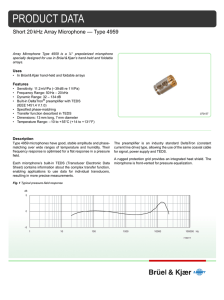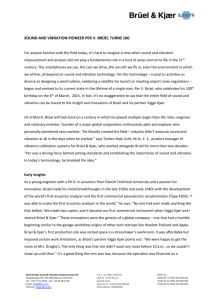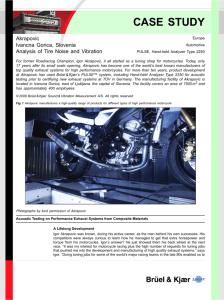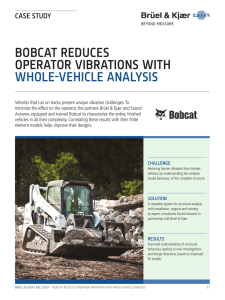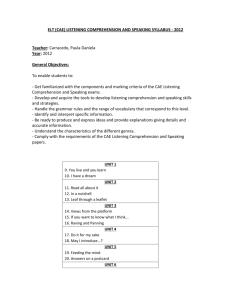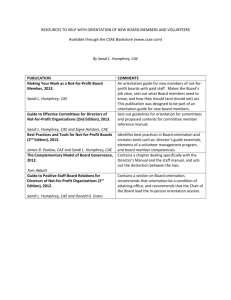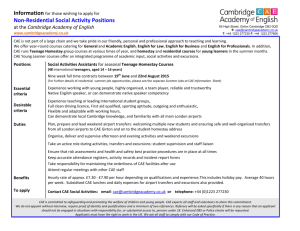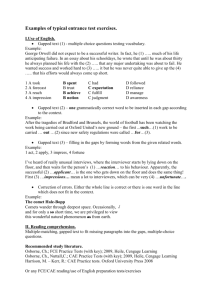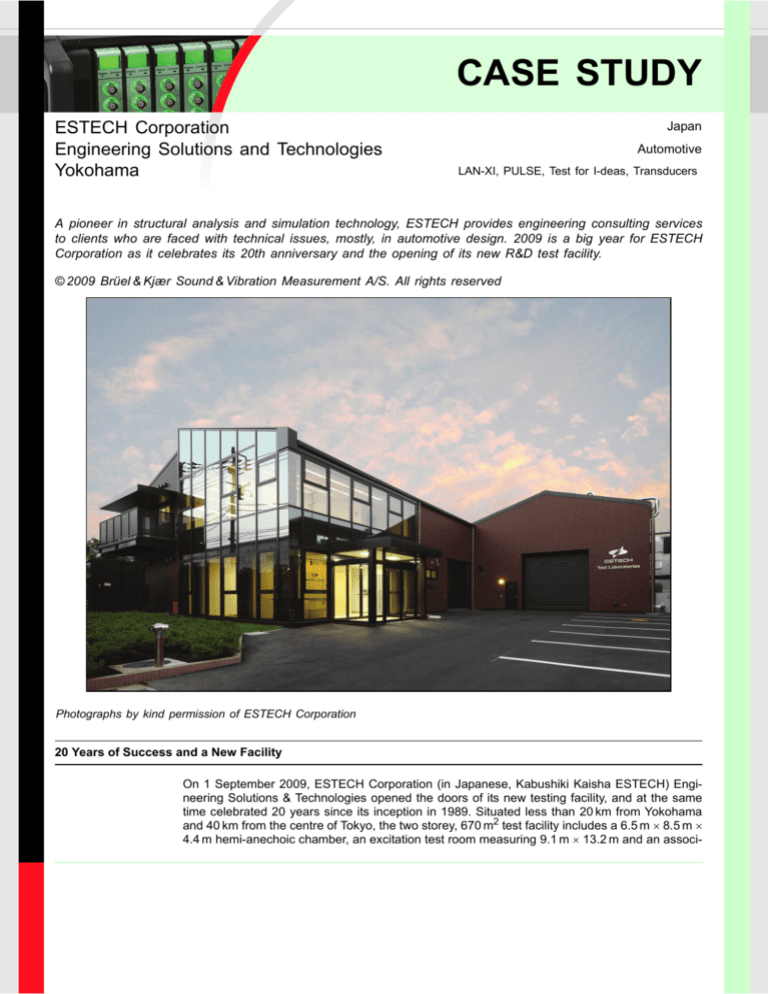
CASE STUDY
ESTECH Corporation
Engineering Solutions and Technologies
Yokohama
Japan
Automotive
LAN-XI, PULSE, Test for I-deas, Transducers
A pioneer in structural analysis and simulation technology, ESTECH provides engineering consulting services
to clients who are faced with technical issues, mostly, in automotive design. 2009 is a big year for ESTECH
Corporation as it celebrates its 20th anniversary and the opening of its new R&D test facility.
© 2009 Brüel & Kjær Sound & Vibration Measurement A/S. All rights reserved
Photographs by kind permission of ESTECH Corporation
20 Years of Success and a New Facility
On 1 September 2009, ESTECH Corporation (in Japanese, Kabushiki Kaisha ESTECH) Engineering Solutions & Technologies opened the doors of its new testing facility, and at the same
time celebrated 20 years since its inception in 1989. Situated less than 20 km from Yokohama
and 40 km from the centre of Tokyo, the two storey, 670 m2 test facility includes a 6.5 m 8.5 m
4.4 m hemi-anechoic chamber, an excitation test room measuring 9.1 m 13.2 m and an associ-
ated test preparation room measuring 10.9 m 10.3 m. The excitation test room, which can be
flexibly partitioned, contains two structural beds which are isolated from external vibration. Two
cranes, able to handle 2.8 tonnes, are available for moving heavy structures such as engines,
tractor cabins and bulky components.
The hemi-anechoic chamber, with less than 7 dBA
background noise is a box-in-box construction and so
that a vehicle can be run inside, there is air conditioning in the ceiling, temperature control and exhaust
extraction. The doors to the chamber are 3.5 m high
allowing king-sized products and components to be
wheeled in. Three of the measurement areas are
totally secure, ensuring complete customer confidentiality. The land and premises cost 5 million US dollars, and it is mainly equipped with Brüel & Kjær
products including four PULSE D-frames, one LANXI D-frame, Test for I-deas software and a range of
transducers.
Making measurements
with PULSE in the
hemi-anechoic
chamber
The Company
ESTECH was established as a joint venture of Nissan Motor Co., Ltd.
and the former SDRC (Structural Dynamics Research Corporation), and
commenced engineering consulting services based on the product
development technology of Nissan and the software and analysis expertise of the former SDRC, a pioneer in MCAE (Mechanical Computer
Aided Engineering). In 2001, ESTECH was bought by Mechanical
Dynamics, Inc., Michigan and in 2002 Mechanical Dynamics were purchased by MSC Software Corp., California.
ESTECH is an engineering consulting company with strong technical expertise in computeraided engineering (CAE), which conducts prognostic evaluation of vibration, noise, mechanics,
heat and other aspects of mechanical product performance, and technologies relating to tests
undertaken by its laboratories. Consulting services provided by ESTECH have received accolades from major manufacturers in the automobile, electrical and precision machinery industries.
So, it was not surprising that ISID (IT Solution Innovator), also a pioneer in the CAE field in
Japan, acquired ESTECH in 2006. The addition of ESTECH as a wholly-owned subsidiary of
ISID could only strengthen and enhance the CAE solutions provided by the parent company.
Today ESTECH boasts 60 employees and hasa capital of 250 million Yen.
Physical Test-driven CAE
Test preparatory room
with car lift
ESTECH’s solutions integrate physical and virtual
prototyping and testing on noise, vibration, motion,
strength, rigidity and thermal phenomena, and CAE
is largely used to meet customer challenges.
ESTECH’s mission is to correlate mathematical
modelling with physical test and thus constantly
improve the quality of the mathematical modelling.
Following a Masters Degree from Purdue University, Indiana, USA, Mr. Toshiro Abe joined Nissan
as Research Engineer working on projects such as
noise reduction of a 4-cylinder engine. He was a
founder member of ESTECH and in 2001 became
the President of ESTECH.
2
Mr. Toshiro Abe, President
of ESTECH
Abe-san says, “The actual phenomena are not simple and,
therefore, we have to do physical testing. The more physical
testing we do, the more we learn about how to build simple but
accurate computer models. Accordingly, physical testing is an
essential companion to CAE”. This ability to perform physical
test and CAE at the same time makes ESTECH unique in
Japan.
ESTECH’s projects can range from a single task to full-vehicle
development projects. However, the majority involve full vehicles or body-in-white where different parameters such as body,
chassis, powertrain, tyres, etc., are tested. For modal analysis
on a full vehicle, the powertrain is normally disconnected as
this makes it easier to identify noise sources. ESTECH also has many projects that are
related to hybrid and electric vehicles and Continually Variable Transmissions (CVTs). Abesan says, “We have been working with electric vehicle technology for about 10 years and
expect this to increase in the future.”
ESTECH also benchmarks competitors’ products
for customers. The data for these benchmark
tests ranges from CAD, drawings, or more usually a complete vehicle. However, most benchmark testing is done using classical modal
analysis using a shaker or impact hammer as the
stiffness and damping of the test object needs to
be ascertained. ESTECH also has access to a
proving ground where they can test drive vehicles
and collect real data.
Artificial Excitation room
with mold platens
ESTECH’s clients include all the major Japanese
manufacturers of cars, trucks, vans, motorcycles
and construction machinery. ESTECH works closely with its clients’ engineers and the project
specifications can be made by the customer or through joint discussion with ESTECH to
decide on the methodology. All raw test data is securely retained by ESTECH but remains the
property of the client.
“ESTECH’s partnership with Brüel & Kjær goes back to 1989,” says Abe-san, “but my personal relationship with Brüel & Kjær dates back to the time I was working for Nissan”.
ESTECH are currently working on a plan to migrate from Test for I-deas to PULSE LabShop
and Reflex, which they are currently evaluating. So why does ESTECH prefer to work with
Brüel & Kjær products? Abe-san explains, “Brüel & Kjær is synonymous with high quality, reliability, has a good reputation and offers outstanding support”. He continues, “Brüel & Kjær
products are certainly not the cheapest but the value we get from the investment is higher
than the cost. We regard Brüel & Kjær as a partner and not a supplier and we enjoy a totally
open relationship”.
HEADQUARTERS: Brüel & Kjær Sound & Vibration Measurement A/S · DK-2850 Nærum · Denmark
Telephone: +45 7741 2000 · Fax: +45 4580 1405 · www.bksv.com · info@bksv.com
2009-10
2009-10
A Business Partner
BN 0659 – 11
BN 0659 – 11
“ESTECH’s capabilities are a key component of its business model,” says Abe-san. “The volume of projects is increasing so we needed more storage, preparation and testing space.
Security requirements are also much tighter than in past years.” He continues, “Therefore, we
decided to expand. It’s a big commitment but I also have a strong belief in our future – a view
that is held by my colleagues and parent company”. By investing in a new facility ESTECH is
ensuring a secure future and the expectation of increased volume necessitates additional
test capability. At the moment ESTECH works mainly for Japanese clients but would like to
expand its business globally.
Rosendahls Bogtrykkeri
Why Invest Five Million US Dollars?

